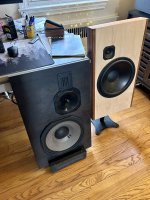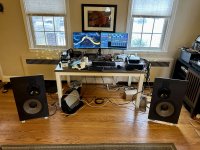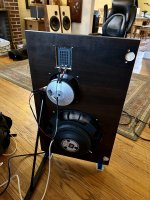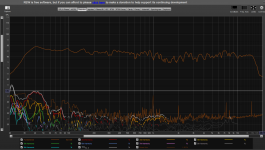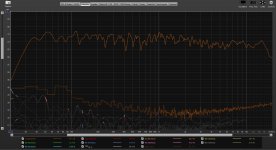It is entirely possible that the driver mounting is responsible for the high 3rd harmonic, I'm pondering what I might change to reduce that.
Just for fun, here are distortion graphs isolating the 15FH500. The first is running wide open, the second with EQ applied to flatten the passband response, the third with EQ and crossover filters applied (1st order HP at 80, LR4 at 400):



What looks like a peak of 3rd HD at 200 Hz is just the distortion in the relatively un-attenuated range, the distortion goes down rapidly with a reduction in signal.
So, my questions for myself are, is this high-ish level of harmonic distortion related to the construction or inherent to the driver, and does it matter at all? If the HD increases rapidly at higher volumes, would a crescendo be accompanied by an burst of distortion, and what would that sound like? If I understand Dr. Geddes' work on the topic of HD in speakers I'd be inclined to believe that it's not audibly significant. I suspect it's not uncommon to chase things that look worse than they sound.
Bill
Just for fun, here are distortion graphs isolating the 15FH500. The first is running wide open, the second with EQ applied to flatten the passband response, the third with EQ and crossover filters applied (1st order HP at 80, LR4 at 400):
What looks like a peak of 3rd HD at 200 Hz is just the distortion in the relatively un-attenuated range, the distortion goes down rapidly with a reduction in signal.
So, my questions for myself are, is this high-ish level of harmonic distortion related to the construction or inherent to the driver, and does it matter at all? If the HD increases rapidly at higher volumes, would a crescendo be accompanied by an burst of distortion, and what would that sound like? If I understand Dr. Geddes' work on the topic of HD in speakers I'd be inclined to believe that it's not audibly significant. I suspect it's not uncommon to chase things that look worse than they sound.
Bill
Heil distortion is very low, also Faital THD in range 60-120 Hz is low.Here is the measured distortion, excluding the subs, in actual SPL and relative. In each graph distortion below the noise floor is greyed out. Both the 15FH500 and the Beta 8a show a bit more 3rd harmonic (yellow trace) than I would like to see, but I'm not sure how audible that would be. I do ponder what drivers would improve performance in those two positions.
Bill
THD peaks on 200 and 600 Hz are not logical, probably not caused directly by drivers cones but are some kind of support, drivers loose fastening or room caused THD.
As far as I have noticed, elevated peaking 3rd harmonic is caused by mechanical problems. In your case it has wide spectrum, which is not typical...
Playing sine wave at peaking H3 and listening to the speaker close, touching it , touching furniture near it or hear mic might help to find the cause.
Playing sine wave at peaking H3 and listening to the speaker close, touching it , touching furniture near it or hear mic might help to find the cause.
Perry, I reread the "Bitches Brew" PDF & didn't see any sketches w/ dimensions of the baffle boards or frames. Is that an oversight or deliberate?
A quick experiment this morning. I tried hanging the 15FH500 from a frame by cords vs. the post mount shown before.As far as I have noticed, elevated peaking 3rd harmonic is caused by mechanical problems. In your case it has wide spectrum, which is not typical...
Playing sine wave at peaking H3 and listening to the speaker close, touching it , touching furniture near it or hear mic might help to find the cause.
Frequency response (no EQ or crossover, just the raw nude driver, no smoothing) is basically unchanged (given the height from the floor has changed and the mic position is not identical):
REW overlays do not allow a single harmonic trace, but THD for the affected range is dominated by the 3rd, so here are the two THD traces:
Again basically unchanged. It looks like the distortion performance not due to the post mounting, it is either the native performance of the driver or due to some systematic error in my measurements.
Here's one more test, THD this time with xover and EQ applied to reflect the final use case, at 70, 80 and 90 dB passband level,:
The green (70 dB ) trace is basically at the noise floor. Distortion is rising a bit faster than the drive level. Does this indicate anything but the driver performance?
I suspect that this is not an audible problem, and at this point I have spent enough this month that i won't be replacing the drivers anytime soon. I'm just obsessing over it because I'm recovering from a mild Covid infection, so I'm basically stuck either in the den or a spare bedroom so as not to share it with my wife, and have nothing better to do.
The post mount would seem to be adequate sonically. It's also about as unobtrusive as it can be, has a fairly small footprint and it's easy to reposition. I think the next step will be to come up with something that looks more finished. Maybe figure out ways to magnet mount the drivers to get rid of the paracord.
I suspect anything more should go in a dedicated thread instead of the gallery.
Bill
Looks like it is the driver itself giving high H3. Spider, surround, frame? Or the mic/stand? Are both units similar?
I checked my measurements and none is showing that kind of H3 dominance with wide spectrum...
I checked my measurements and none is showing that kind of H3 dominance with wide spectrum...
Other of my two 15fh520 has ratling wires, wires from binding post to voice coil makes contact to cone when it moves in. Surely would show up in distortion plot. Try listen if hardware on the driver makes noise, blowing, rubbing and rattling sort of stuff.
If the driver was boxed not sure if it was that audible, especially in live PA application.
If the driver was boxed not sure if it was that audible, especially in live PA application.
OK, one more post on the subject. I spent some time with a mic 'in hand' yesterday, playing sine waves and watching the RTA screen from across the room. As I got the mic closer to the driver, the 3rd harmonic peak got smaller relative to the signal and the 2nd. This was true on any axis. It occurred to me that Klippel distortion measurements on completed speakers as published at ASR or Erin's Audio Corner are derived from near-field measurements, not far field measurements as I was showing. HiFi Current's distortion measurements are also taken from closer mic positions, either 310 or 20 mm. This morning I found this note https://www.erinsaudiocorner.com/testmethods/. This all threw my previous distortion measurements into doubt.
Here's the 15FH500 again, nearfield distortion measurement, using stepped sine this time rather than a sweep, over the driver's passband with EQ and xovers applied, same drive level as before but higher SPL due to close mic position:

This is more what I would expect, 2nd harmonic dominates, the rest are much lower.
Can I conclude that the higher distortion I was measuring was more a measurement artifact due to room influence than an accurate representation of the actual driver behavior? The more I play around, the more I learn.
Bill
Here's the 15FH500 again, nearfield distortion measurement, using stepped sine this time rather than a sweep, over the driver's passband with EQ and xovers applied, same drive level as before but higher SPL due to close mic position:
This is more what I would expect, 2nd harmonic dominates, the rest are much lower.
Can I conclude that the higher distortion I was measuring was more a measurement artifact due to room influence than an accurate representation of the actual driver behavior? The more I play around, the more I learn.
Bill
Is your mic OK? Can you get any other mic for comparison?Can I conclude that the higher distortion I was measuring was more a measurement artifact due to room influence than an accurate representation of the actual driver behavior? The more I play around, the more I learn.
Bill
Big fun today. Making a mess and sawdust, continuing experiments from post #4033.
https://www.diyaudio.com/community/threads/ultimate-open-baffle-gallery.123512/post-7208656
https://www.diyaudio.com/community/threads/ultimate-open-baffle-gallery.123512/post-7208656
- $5 IKEA cabinet doors from the junk section, 30x18 in. chipboard
- Holes cut with a handheld jigsaw
- Big shelf brackets I bought for a turntable wall mount project that never materialized (too chicken to drill into plaster)
- No chamfering of mid or tweeter openings, yet (haven’t decided on a method for that yet)
- Crossovers and EQ by ear for now have been fun
- Measurements pending
Attachments
Two open baffle done in the same time
First, I have use my old drivers in my stock. 2xSLS263 + 22W85534 + 27dxt. 79dB sensitivity 40Hz-20Khz 400Hz and 1500Hz crossover frequency. I would use a 7" instead a 8" for mid but I have had the excellent Scanspeak which works well in the treble. This baffle is compact 30cm large. I have done a work on the impedance to keep it flat as possible 3 to 12 ohms in the whole band. Still work in progress to have a balanced sound.

The second : I use the new SB Acoustics (2x) 12OB150 , the SICA 5,5H1,5CP for aesthetic reason and two 27tbcg with one, the front in the Visaton waveguide WG148R.
87db sensitivity, crossover 500Hz and 1900Hz - 40Hz to 20Khz. All the drivers sounds very well ! I like a lot the 12" because it is fast and delivers a very detailed sound in the bass. I thing the cone mass is the key. I prefer this 12" over the SLS315 which is a good driver, goes lower but the cone mass is high. I would like test the 15OB350 but the baffle will be too large for me. This speaker has a long story, I would made a FAST with a 3FE25 but not convinced by the result, the 3" was yelling at high sound level. Go to a classic 3 ways. The SICA is a very good surprised this driver works well, a bargain for the price but it is rising. Also this speaker has a "flat" impedance curve (4 to 12 ohms).

First, I have use my old drivers in my stock. 2xSLS263 + 22W85534 + 27dxt. 79dB sensitivity 40Hz-20Khz 400Hz and 1500Hz crossover frequency. I would use a 7" instead a 8" for mid but I have had the excellent Scanspeak which works well in the treble. This baffle is compact 30cm large. I have done a work on the impedance to keep it flat as possible 3 to 12 ohms in the whole band. Still work in progress to have a balanced sound.
The second : I use the new SB Acoustics (2x) 12OB150 , the SICA 5,5H1,5CP for aesthetic reason and two 27tbcg with one, the front in the Visaton waveguide WG148R.
87db sensitivity, crossover 500Hz and 1900Hz - 40Hz to 20Khz. All the drivers sounds very well ! I like a lot the 12" because it is fast and delivers a very detailed sound in the bass. I thing the cone mass is the key. I prefer this 12" over the SLS315 which is a good driver, goes lower but the cone mass is high. I would like test the 15OB350 but the baffle will be too large for me. This speaker has a long story, I would made a FAST with a 3FE25 but not convinced by the result, the 3" was yelling at high sound level. Go to a classic 3 ways. The SICA is a very good surprised this driver works well, a bargain for the price but it is rising. Also this speaker has a "flat" impedance curve (4 to 12 ohms).
I'm still learning with REW and MiniDSP, but here is where I've made it with some tweaking this evening. Measured with a Umik-1 on axis ~0.5M from the mid.
It definitely sounds better than what I was shooting around in the dark with yesterday. That had a massive valley between 200 and 2K. 😀
This is BIG fun.
It definitely sounds better than what I was shooting around in the dark with yesterday. That had a massive valley between 200 and 2K. 😀
This is BIG fun.

Attachments
Last edited:
As a midrange response at 0.5m in front of the whole speaker, this is a pretty good result, if incomplete. The massive valley as you call it is really a couple of dB down between 1 -2kHz - not perfectly flat but it never is! Try a measurement at 1m (perhaps outside) to avoid the room's effects
It's well known but often forgotten that the room contributes somewhere between 40 - 60% of the final sound where you actually listen to the music, so the on axis 'near-field' flat freq response is just a starting point - it will invariably need some 'tweeking'.
Also, as many people like a sloping roll-off (up to 10dB/dec) at the listening position (that includes the room artifacts), your freq response is rather good
It's well known but often forgotten that the room contributes somewhere between 40 - 60% of the final sound where you actually listen to the music, so the on axis 'near-field' flat freq response is just a starting point - it will invariably need some 'tweeking'.
Also, as many people like a sloping roll-off (up to 10dB/dec) at the listening position (that includes the room artifacts), your freq response is rather good
Thanks, @jameshillj !
The valley I mentioned was from my first measurement, before today’s tweaking. The picture in my previous post was after several adjustments based on iterative measurements. The whole system was too bass heavy before (though that was fun!).
Tomorrow I will get some measurements at the listening position.
The valley I mentioned was from my first measurement, before today’s tweaking. The picture in my previous post was after several adjustments based on iterative measurements. The whole system was too bass heavy before (though that was fun!).
Tomorrow I will get some measurements at the listening position.
- Home
- Loudspeakers
- Multi-Way
- Ultimate Open Baffle Gallery

